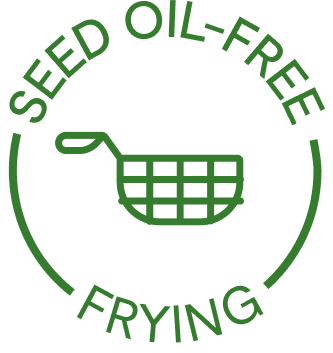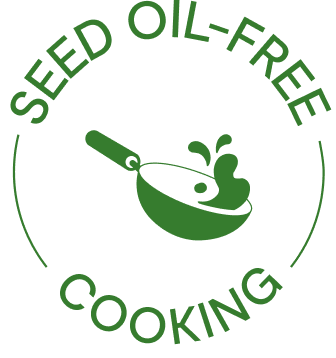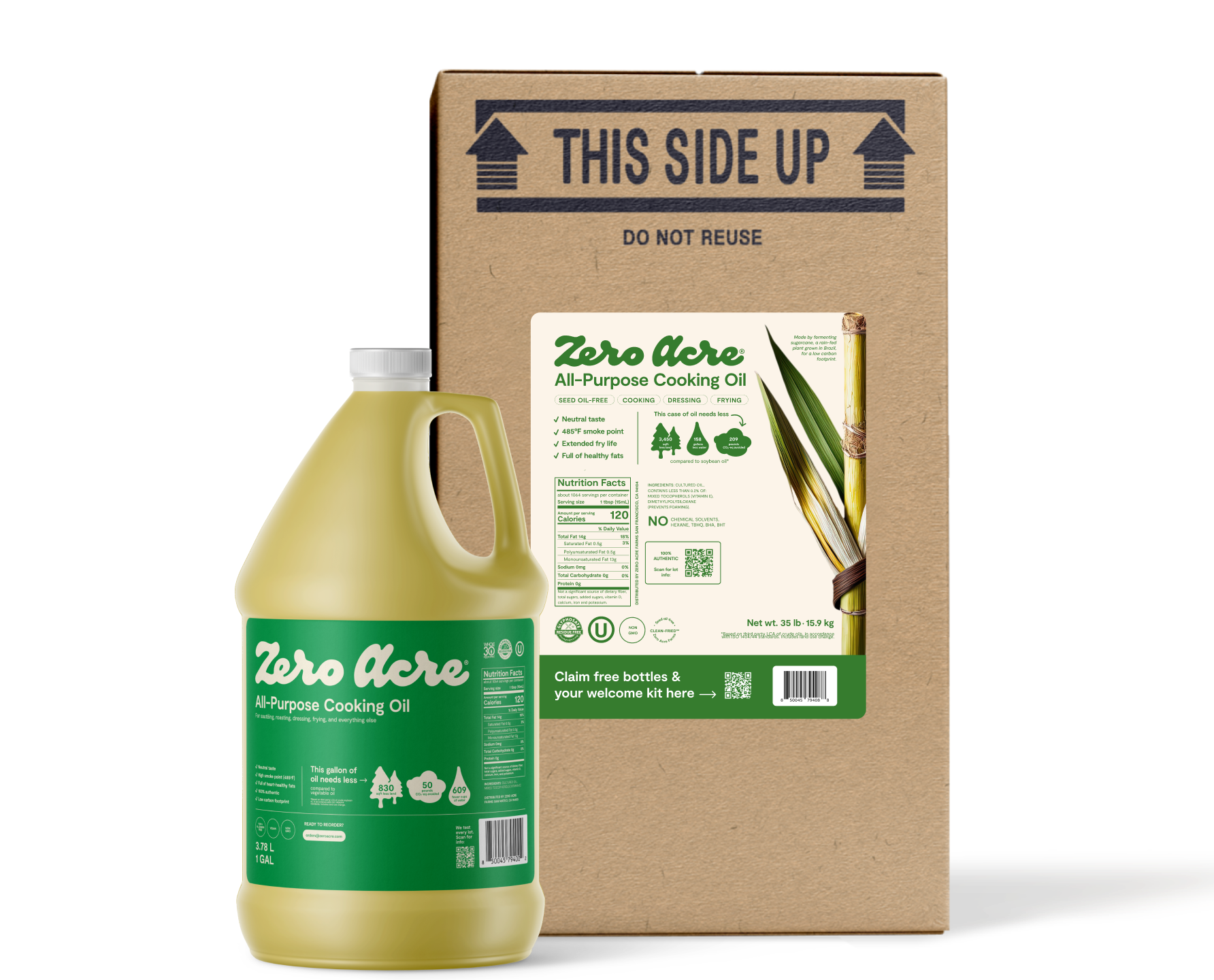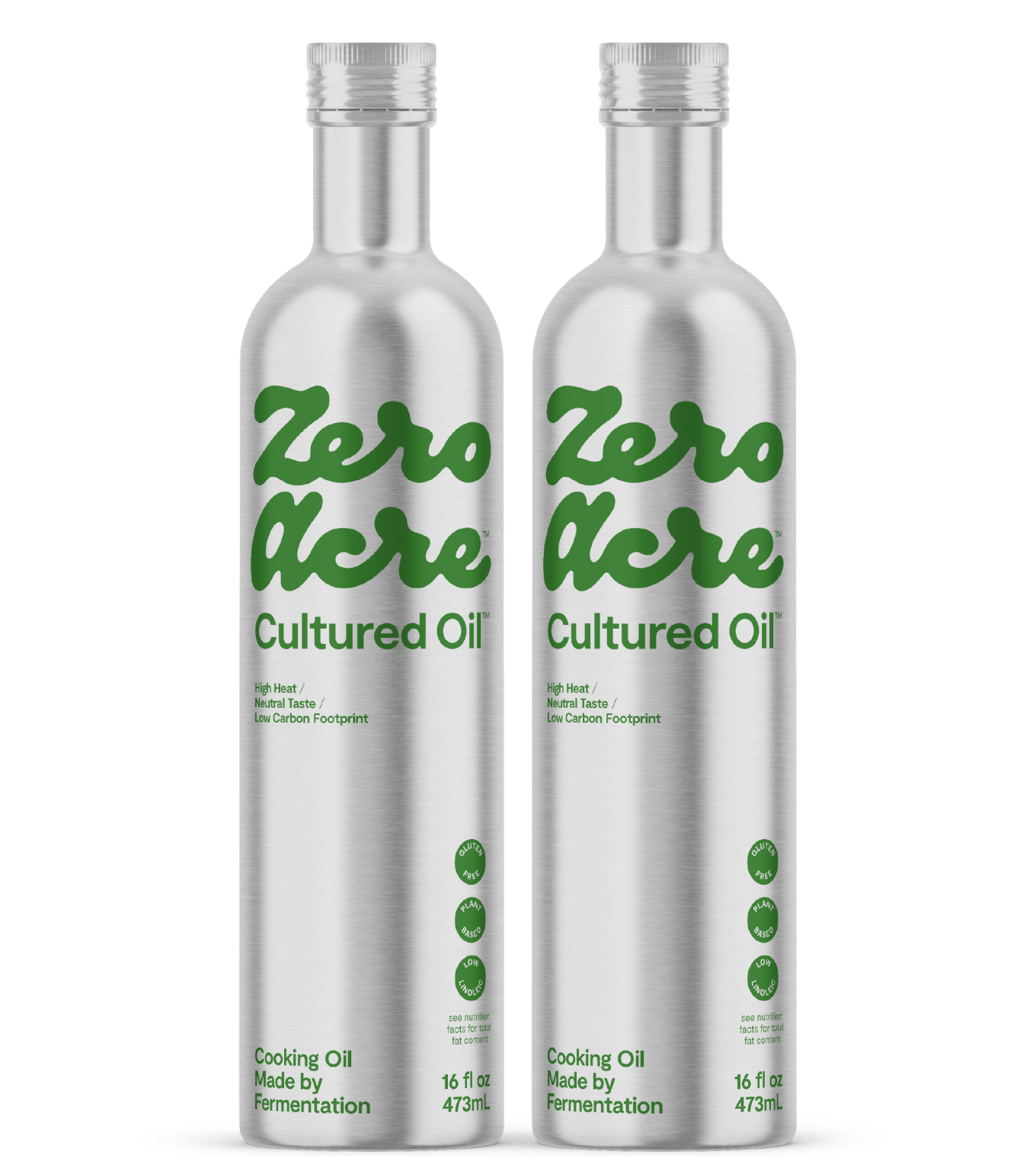Want to get in touch? Have a few questions? We’re here to help.
At this time, we are not able to ship internationally. We only ship to the contiguous United States for now, but keep an eye out as we grow.
Our team is happy to take a look for you. Just send us an email at hello@zeroacre.com and we’ll see what we can do. Please note, we are not able to change or modify orders that have already shipped.
Zero Acre oil is sky high in heart-healthy and heat-stable monounsaturated fat. Every batch of Zero Acre oil contains 90-94% monounsaturated fat, and less than 4% polyunsaturated (including less than 3% omega-6 linoleic acid) and saturated fat. Per 14 gram (1 tablespoon) serving of Zero Acre oil, that translates to about 13g monounsaturated fat, 0.5g saturated fat, and 0.5g polyunsaturated fat.
Look up the fat profile of your specific bottle of Zero Acre oil.
Yes, Zero Acre oil is a one-to-one replacement for all liquid vegetable oils, including soybean oil, canola oil, sunflower oil, safflower oil, grape seed oil, rice bran oil, cottonseed oil, corn oil, peanut oil, avocado oil, and palm olein.
When it comes to choosing a healthy fat, olive oil is a much better option than seed oils such as soybean oil, corn oil, grapeseed oil, and safflower oil. However, olive oil has a number of drawbacks as well, including a large environmental footprint, a low smoke point, and a history of adulteration and mislabeling. When deciding whether to use olive oil or Zero Acre oil, here’s what to keep in mind:
Taste: Most olive oil has a moderate to strong flavor, with bitter, grassy, and peppery notes. Zero Acre oil has a more neutral taste, with subtle buttery or nutty notes.
Healthy fats: Olive oil is often prized for its high monounsaturated fat content, containing between 55-83% of the heart-healthy fat. Zero Acre oil contains over 90% monounsaturated fat.
Omega-6 fats: Most olive oils contain on average about 13% omega-6 linoleic acid, with some olive oils containing up to 27%. Excess linoleic acid consumption has been linked to inflammation and other health issues. Zero Acre oil contains about 3% linoleic acid.
High heat cooking: Olive oil has a low smoke point and moderate oxidative stability at high heat. Zero Acre oil has a high smoke point and very high oxidative stability at high heat.
Cold applications: Olive oil remains liquid at room temperature and slowly solidifies during refrigeration. Zero Acre oil remains liquid both at room temperature and in the refrigerator. (A 70/30 blend of Zero Acre oil and extra virgin olive oil in a dressing allows for the flavor of the olive oil to pop, while remaining liquid in the refrigerator).
Antioxidants: Both olive oil and Zero Acre oil contain antioxidants, including tocopherols. Extra virgin olive oil also contains a variety of phenolic compounds, namely tyrosol, hydroxytyrosol and pinoresinol.
Environmental impact: Olive oil is one of the thirstiest crops, second only to almonds, and requires significantly more land to produce than other major oil crops. The production of Zero Acre oil has a very small environmental footprint relative to olive oil, requiring 99% less water and 95% less land. In addition, Zero Acre oil’s carbon footprint is less than half that of olive oil’s (unrefined).
Adulteration: The olive oil industry has a history of adulteration, with some reports estimating that 75-80% of all extra virgin olive oil in the U.S. is adulterated. Zero Acre oil is guaranteed authentic. Each bottle of Zero Acre oil is linked to a single batch and customers can scan a QR code on the bottle to look up its unique composition and authenticity.
As part of our mission to improve the health of not only people, but also the planet, we use 100% recyclable aluminum packaging, in addition to a 100% recyclable kraft shipping box.
Aluminum is lighter and more sustainable than glass and infinitely recyclable. Infinitely recyclable refers to materials that can be recycled an infinite number of times without the quality of the material degrading. While the phrase “recyclable” is attached to countless products these days, that doesn’t mean they can all be recycled forever.
Today, about 75% of all aluminum produced in history, nearly a billion tons, is still in use. Studies find that consumers are also about 70% more likely to recycle aluminum than glass or plastic. And because aluminum is lighter than glass, it is more environmentally friendly in transportation.
Unlike glass (even dark green or amber-tinted bottles), aluminum packaging also completely blocks UV light, making the oil less susceptible to oxidation, rancidity, and waste. It’s also less susceptible to breaking or cracking than glass, further reducing waste.
We sure do! You can apply to join the movement HERE.
Email us anytime at hello@zeroacre.com! Our support team is available to help Monday - Friday 9am - 5pm.
We're here to help! No really, we are
hello@zeroacre.com







